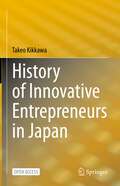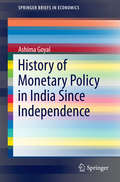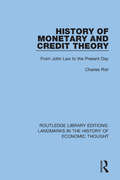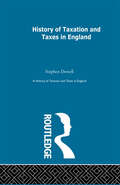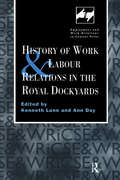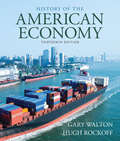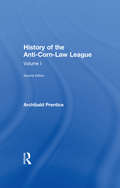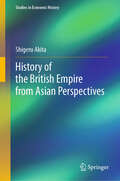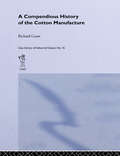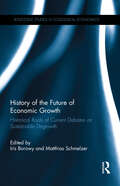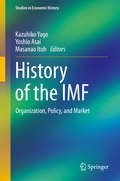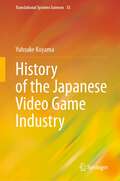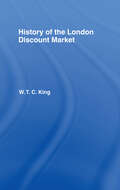- Table View
- List View
History of Innovative Entrepreneurs in Japan
by Takeo KikkawaThis is the first Open Access book introducing more than 20 of Japan’s leading innovative entrepreneurs from the 17th century to the present. The author outlines the innovative business models created by entrepreneurs including SoftBank’s Masayoshi Son, Fast Retailing (Uniqlo)’s Yanai Tadashi, Honda’s Soichiro Honda, Sony’s Akio Morita, Panasonic’s Konosuke Matsushita, and Toyota’s Kiichiro Toyoda, as well as their predecessors including Takatoshi Mitsui of Mitsui Zaibatsu, Shibusawa Eiichi of Daiichi Bank. While introducing the innovators, the author also raises three broader questions: 1. Why did Japan industrialize earlier than any other country outside Europe and the United States? 2. Why was Japan able to realize unsurpassed economic growth between the 1910s and the 1980s? 3. Why has Japan’s economy stagnated for more than 30 years since the 1990s? Drawing upon analytical concepts including Schumpeter’s breakthrough innovation, Kirzner’s incremental innovation, and Christensen’s disruptive innovation, the author contends that Japan’s successes were based on unique and systematic breakthrough innovation and an accumulation of incremental innovation, while it later fell victim to a combination of breakthrough innovation from advanced countries and disruptive innovation by developing nations.
History of Investment Banking
by Thomas J. Delong Ashish Nanda Lynn Villadolid RoyDescribes the history of investment banking.
History of Japanese Economic Thought (Nissan Institute/Routledge Japanese Studies)
by Tessa Morris SuzukiEconomics, in the modern sense of the word, was introduced into Japan in the second half of the nineteenth century. However, Japanese thinkers had already developed, during the seventeenth and eighteenth centuries, a variety of interesting approaches to issues such as the causes of inflation, the value of trade, and the role of the state in economic activity. Tessa Morris-Suzuki provides the first comprehensive English language survey of the development of economic thought in Japan. She considers how the study of neo-classical and Keynesian economics was given new impetus by Japan's 'economic miracle' while Marxist thought, particularly well established in Japan, was developing along lines that are only now beginning to be recognized by the West. She concludes with an examination of the radical rethinking of fundamental economic theory currently occuring in Japan and outlines some of the exciting new approaches which are emerging from this 'shaking of the foundations.
History of Management Thought: Genesis and Development from Ancient Origins to the Present Day (Contributions to Management Science)
by Vadim I. MarshevThis book describes the millennia-long process of the genesis, formation, struggle, and change of views on the management of social organizations in various countries around the world; in other words, it characterizes the worldwide evolution of the History of Management Thought (HMT) - ideas, concepts, theories, paradigms, and scientific schools - from Antiquity to the present. The book is the outcome of extensive research, based on the analysis, generalization, and systematization of foreign and domestic published literature, as well as on the gathering and analysis of unique archival materials. For the first time in the historical and managerial literature, the book puts forward original definitions of three historical and managerial sciences - the History of Management, the History of Management Thought, and the Historiography of Historical and Managerial Research. It addresses the main challenges in pursuing Historical and Scientific Research (HSR), the main “subject” levels of HSR and specific methodological problems concerning HMT, as well as epistemological methods for identifying key factors in and causes of the advent and evolution of HMT. This book presents both the origins of management thought dating back to the 5th millennium BC and the latest management concepts of the early 21st century. In particular, it traces the origins and sources of management thought, reflected in the works of thinkers and statesmen of the Ancient World (Egypt, Western Asia, China, India, Greece, and Rome), the era of feudalism, and the Middle Ages (Byzantium, Western Europe, and England), the era of inception capitalism (Western Europe and the USA), as well as the new and recent history of management thought of the 20th and 21st centuries. In addition, for the first time in History of Management literature, it presents the history of Russian management thought from the 9th century to modern concepts and scientific schools.
History of Monetary Policy in India Since Independence
by Ashima GoyalThe book discusses Indian post-independence monetary history in the context of the country's development and the global changes of the period. The conceptual framework used is the SIIO (Structure, Ideas, Institutions and Outcomes) paradigm. That is, structure and ideas become embedded in institutions and affect outcomes. Narrative history, data analysis and research reports demonstrate the dialectic between ideas and structure with respect to monetary history, aspects of India's development, and the global institutions and events that impacted monetary choices. The history of the economy and of the global changes that affected it covers a time when major changes took place both in India and internationally. India's greater openness is important both for it and for the world, but it occurred at a time of major global crises. How did these impact monetary choices and how did the latter help India navigate the crises while maintaining its trajectory towards greater liberalization? The book explores these and other relevant but under-analyzed questions. The initial combination of ideas and structure created fiscal dominance and made monetary policy procyclical. An aggregate supply-and-demand framework derived from forward-looking optimization subject to Indian structural constraints is able to explain growth and inflation outcomes in the light of policy actions. Using exogenous supply shocks to identify policy shocks and to isolate their effects, demonstrate that policy was sometimes exceedingly strict despite the common perception of a large monetary overhang. Surges and sudden stops in capital flow also constrained policy. But the three factors that cause a loss of monetary autonomy--governments, markets and openness--moderate each other. Markets moderate fiscal profligacy and global crises moderate market freedoms and ensure openness remains a sequenced and gradual process. The book argues greater current congruence between ideas and structure is improving institutions and contributing to India's potential.
History of Monetary and Credit Theory: From John Law to the Present Day (Routledge Library Editions: Landmarks in the History of Economic Thought)
by Charles RistOriginally published in 1940, this book traces the development of theories concerning currency and credit from the beginning of the eighteenth century to the middle of the twentieth. It provides a comprehensive account of the political and economic conditions in which the theories and controversies arose, with the result that the work has become a classic in its field.
History of PR in Canada: An Annotated Bibliography and Critical Historiography of Public Relations Research in Canada (The History of Public Relations)
by Sandra L. Braun Ella Palin Hannah FarrowA first of its kind, this annotated bibliography provides an overview of the development of public relations research in the Canadian context. A valuable resource for researchers, students or practitioners, this bibliography surveys the landscape of public relations research in Canada. It orientates readers to this unique history, identifies gaps in research, suggests topics of future research, and offers critical historiography.This reference work will be of interest to scholars, students and practitioners in the fields of strategic communications, marketing or communications, providing a greater understanding of communications research in various Canadian contexts such as government, industry, corporate and nonprofit.
History of Protective Tariff Laws (Routledge Library Editions: International Trade Policy #13)
by R.W. ThompsonThis book, first published in 1888 and reprinted in 1974, offers a history of US protective tariffs and their consequences for that country’s international trade, particularly with Great Britain. Its aim was to present to the reader the arguments for and against the opposing principles of protection and free trade, and in this it is successful – the book is a comprehensive analysis of the issue, seen from a time when the debate was perhaps at its most intense.
History of Public Accounting in the United States (Routledge Library Editions: Accounting History #28)
by James Don EdwardsThis book, first published in 1988, is a readable, concise history of the accounting profession in the US from its beginnings to the late twentieth century. It examines the roots of the profession, how it developed, how its standards have evolved, and what social, economic and legal forces have shaped it. The chapters form a series of dramatic highlights, illustrative of the multifarious problems besetting a young profession, catapulted into prominence by the economic and social forces of the twentieth century.
History of Taxation and Taxes in England Volumes 1-4: From The Earliest Times To The Present Day; Volume 3
by Stephen DowellFirst published in 1965. This is four volumes in one text on Taxes and Taxation from the earliest times to the present day. The first volume looks at the history of taxation and tax in England, then Volume II the taxation period from the Civil War to the present day, volume II concerns itself with direct taxes and stamp duties; and finally Volume IV concludes with taxes on articles of consumption.
History of Work and Labour Relations in the Royal Dockyards (Routledge Studies in Employment and Work Relations in Context)
by Kenneth Lunn Ann DayFirst published in 1999. Routledge is an imprint of Taylor & Francis, an informa company.
History of the American Economy: War And The Us Economy From The Spanish-American War To The Persian Gulf War (New Approaches To Economic And Social History Series)
by Hugh Rockoff Gary M. WaltonEver wonder how the American economy became the most powerful one in the world? Tying America's past to the economic policies of today and beyond, the popular HISTORY OF THE AMERICAN ECONOMY, 13E answers this critical question and more, presenting events chronologically for easy understanding. This prestigious book has been used by more learners than any other of its kind in the U.S. Market-leading HISTORY OF THE AMERICAN ECONOMY has helped generations of learners understand how the American economy evolved. Completely updated with recent research by economic historians, this trusted book ties this country’s past to the policies and debates of today and beyond. Visual aids, tables and graphs reinforce learning and encourage interest in the study of economic history.
History of the Anti-Corn Law League
by Archibald PrenticeFirst Published in 1968. This second edition of the History of the Anti-Corn-Law League features a new introduction by W. H. Chaloner while the main text pursues the goal of cataloguing and archiving the timeline of events within the executive council. The beginning of 1848 saw workmen busily engaged in erecting the Free Trade Hall by which time it was supposed the Corn Law would be repealed. This remained standing, often used, until 1853, when its defeat showcased that the principles of free trade were fully recognized and the historical timeline for this edition begins.
History of the Anti-Corn Law League
by Archibald PrenticeFirst Published in 1968. This is Volume I of a series of studies in Economic and Social History series and looks at how the Corn Laws regulated the internal trade, exportation and importation and market development from the twelfth to the eighteenth centuries.
History of the Anti-Corn Law League
by Archibald PrenticeFirst Published in 1968. This is Volume I of a series of studies in Economic and Social History series and looks at how the Corn Laws regulated the internal trade, exportation and importation and market development from the twelfth to the eighteenth centuries.
History of the Bank of England
by A.M. AndreadesFirst Published in 1966. Routledge is an imprint of Taylor & Francis, an informa company.
History of the British Empire from Asian Perspectives (Studies in Economic History)
by Shigeru AkitaThis book presents the history of the British Empire as the “Bridge” for creating a Global History, especially emphasizing its connections with Asian regions. The United Kingdom ruled most of the world in the nineteenth century. Its influence spread around the globe in various forms – in the white settlements such as those in Canada, Australia, and New Zealand (Dominions), in Asian and African regions represented by present-day India, in colonies acquired by military force (Dependencies), and in other regions under its economic influence through trade and investment (the informal empire). Thus, the British Empire played a key role in nineteenth-century globalization. There are many books on the British Empire in English. However, no books from Asian perspectives have interpreted it as “the means used by Asian countries for their own economic development” (and as providers of “international public goods”). Along with the East Asian economic resurgence, the weight of the global system and the world economy has now largely shifted from the Atlantic world to the Asia-Pacific region, encompassing India, as well as the Pacific coast of the United States. The global depression in 2008 accelerated this trend. We now face the task of building a new interpretation of world history with a clearer understanding of this upheaval. Redrawing world history is not an easy task but a good starting point would be to analyze the mutual relationship between the British Empire and the Asian regions, and this can be done by interpreting the historical significance of the British Empire.
History of the Cotton Manufacture in Great Britain: With A Disproval Of The Claim Of Sir Richard Arkwright To The Invention Of Its Ingenious Machinery - (Cambridge Library Collection - Technology Ser.)
by Edward BainesFirst Published in 1966. Routledge is an imprint of Taylor & Francis, an informa company.
History of the Future of Economic Growth: Historical Roots of Current Debates on Sustainable Degrowth (Routledge Studies in Ecological Economics)
by Matthias Schmelzer Iris BorowyThe future of economic growth is one of the decisive questions of the twenty-first century. Alarmed by declining growth rates in industrialized countries, climate change, and rising socio-economic inequalities, among other challenges, more and more people demand to look for alternatives beyond growth. However, so far these current debates about sustainability, post-growth or degrowth lack a thorough historical perspective. This edited volume brings together original contributions on different aspects of the history of economic growth as a central and near-ubiquitous tenet of developmental strategies. The book addresses the origins and evolution of the growth paradigm from the seventeenth century up to the present day and also looks at sustainable development, sustainable growth, and degrowth as examples of alternative developmental models. By focusing on the mixed legacy of growth, both as a major source of expanded life expectancies and increased comfort, and as a destructive force harming personal livelihoods and threatening entire societies in the future, the editors seek to provide historical depth to the ongoing discussion on suitable principles of present and future global development. History of the Future of Economic Growth is aimed at students and academics in environmental, social, economic and international history, political science, environmental studies, and economics, as well as those interested in ongoing discussions about growth, sustainable development, degrowth, and, more generally, the future.
History of the IMF
by Kazuhiko Yago Yoshio Asai Masanao ItohThis book describes the history of the IMF from its birth, through the Bretton Woods era, and in the aftermath. Special attention is paid to integrating IMF history with the macro-economic policies of member countries and of other international institutions as well. This collection of work presents a clear understanding, inter alia, of the influence of the United States over IMF policy via the National Advisory Committee; the dealings of the IMF with the UK on pound sterling policy; the institutional change of the IMF brought about by Per Jacobsson, the third managing director; and France, Italy, Germany, Canada, and Japan vis-à-vis IMF consultations. It also provides the reader with topics concerning the bankers' acceptance market function and international liquidity issues in relation to IMF policy; the final chapter sheds light on the long-standing relations between the IMF and China, from the Bretton Woods Agreement to the contemporary period. All the chapters are archive-based academic studies providing deep insights with historical background, which makes this book the first thoroughly independent achievement in the field of IMF history. This book is highly recommended to readers interested in contemporary monetary and financial history and those who seek to obtain a coherent image of postwar international institutions and markets.
History of the Japanese Video Game Industry (Translational Systems Sciences #35)
by Yusuke KoyamaThis book is the first one to describe the entire history of the video game industry in Japan. The industry consists of multiple markets—for PCs, home consoles, arcades, cellular phones and smart phones—and it is very difficult to see the complete picture. The book deals comprehensively with the history of the Japanese game industry from the beginning of the non-computer age to the present. The video game industry in Japan was established in the arcade game market when Space Invaders was released by Taito in 1978. Game markets for both PCs and home consoles followed in the early 1980s. The platform that occupies a central market position started with the arcade and shifted, in order, to the home console, handheld consoles, and smart phones. In the video game industry in the twentieth century each platform had a clear identity, and the relationships among platforms were "interactions". In the twenty-first century, with the improvement of computer performance, the platform identity has disappeared, thus the relationship among platforms is highly competitive. Since the "crash of 1983" in the United States, the Japanese game industry has one of the largest market shares in the world and has developed without being influenced by other countries. It reached its peak in the late 1990s, and then its relative position declined due to the growth of foreign markets and the failure of emerging markets such as online PC games. Even today, Japan's gaming industry holds a dominant position in the world, but it is not the superpower it once was. Since the beginning of the twenty-first century, game research has become active worldwide. Among game researchers, there is a large demand for research on games in Japan, but there is still little dissemination of research in English. The original version of this book published in Japan is highly regarded and received an award for excellence from the Society of Socio-Informatics in 2017.
History of the Labor Movement in the United States Vol. IV: The Industrial Workers of the World 1905-1917
by Philip S. FonerDedicated to Elizabeth Gurley Flynn, this is the stirring account of IWW battles West and East.
History of the Labor Movement in the United States, Vol. II: From the Founding of the American Federation of Labor to the Emergence of American Imperialism
by Philip S. FonerThis work includes information about: '80s Socialist movement and Labor, the Knights of Labor, Haymarket and May Day, Labor political action, the rise of the AFL, the Homestead strike, Coal creek and Cour d'Alene, American Railway Union, Pullman strike, Labor populism, Labor and the Spanish-American War, Labor and imperialism, and more.
History of the Labor Movement in the United States, Vol. III: The Policies and Practices of the American Federation of Labor, 1900-1909
by Philip S. FonerLabor at the turn of the Century; Open-shop drive; National Civic Federation; The church and labor; business unionism; Craft vs industrial unions; Women, Black and immigrant workers; AFL political policies; the Socialists; Western Federation of Miners; the American Labor Union, more.
History of the London Discount Market
by W. T. KingFirst Published in 1972. Routledge is an imprint of Taylor & Francis, an informa company.
